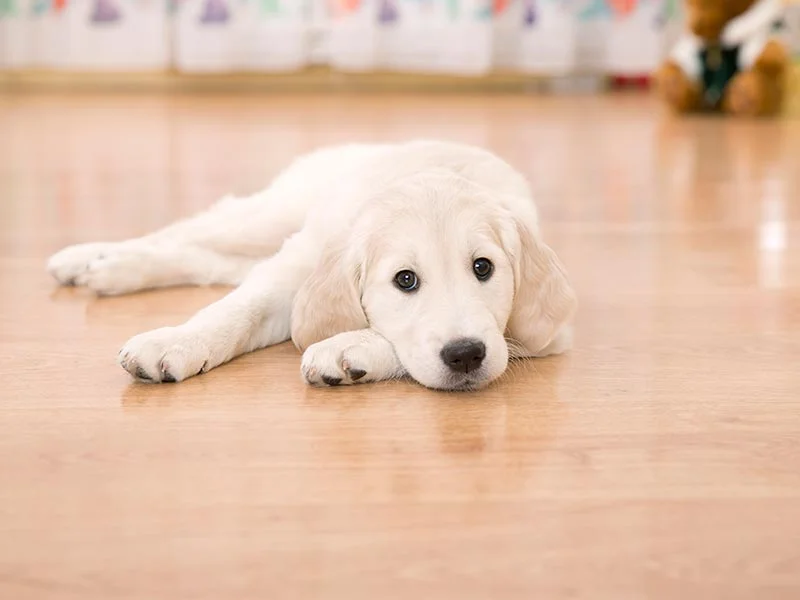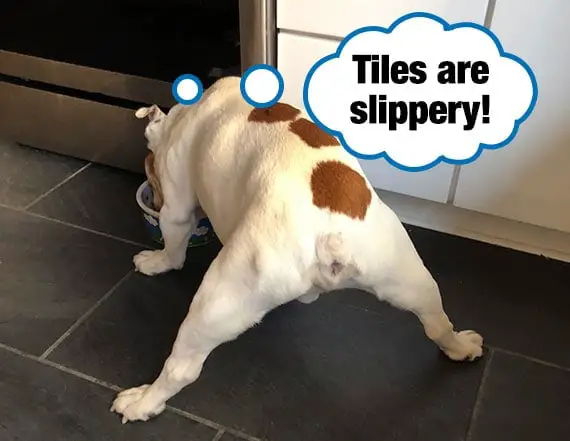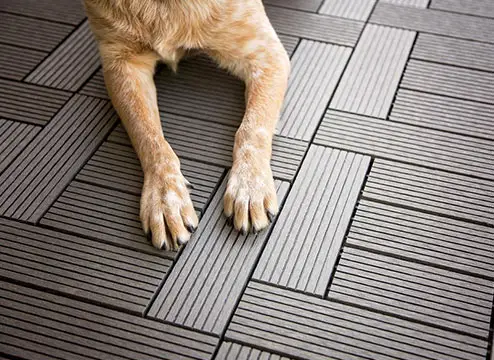Are Tile Floors Bad for Dogs? (Explained With Solutions to Sliding)
Before picking those shiny pieces of ceramics to install, remember that flooring is that aspect of your home that can have a drastic impact on your dog’s health and quality of life. And unless you want your pooch in an awkward ice-skating or starfish posture all day, you have to get things right here.
There are different types of tile floors but this article will be narrowed down to the most commonly used. So, more specifically, are ceramic tile floors bad for dogs?
While tiles are undeniably durable and are quite easy to clean, they make bad flooring for dogs as their paws are not designed to walk on such smooth surfaces. Dogs that keep slipping on attempts to walk on tiles often end up with injuries, joint problems, anxiety, and fear.
When relocating to a new home with your beloved pet, it is advisable to look into flooring options with textured surfaces. However, if you’re stuck with dog-slippery flooring in your current home, you can still modify the flooring in those specific areas where your pet spends most of its time.
Key takeaways
Tiles can strain dogs’ joints, especially in older or hip-issue-prone breeds.
Slippery tiles can lead to dog accidents and injuries.
Hard and cold tiles may be uncomfortable for dogs to rest on.
Cold tile floors can help some dogs cool down.
Tiles are easier to clean up pet messes than carpets.
Tiles can increase household noise due to acoustics.
Area rugs or dog mats can make tiles more pet-friendly.
Regular nail trimming prevents scratches on tiles.
Are Tile Floors Bad For Dogs?
Indeed, tiles make terrible walking surfaces for canines because of their slippery properties which makes them potentially hazardous to dogs’ health.
If you are looking for what’s best for your doggo, simply look away from not just tiles but other smooth flooring material including hardwood and laminate flooring that makes paw traction difficult for dogs.
Canines don’t have great footing on these surfaces, often making them slip with their limbs in an extended position. This results in excessive tension on your dog’s muscles and ligaments eventually causing them to tear. In other situations, your dog may fall and be left with serious injuries.
In essence, it is easier to simply opt for a dog-friendly floor than to incur extra expenses from trips to the vet.
Slippery Floors And Hip Dysplasia In Dogs
Because of the prevalence of hip dysplasia, it’s important to understand how intertwined it is with slippery surfaces.
Hip dysplasia is a deformity of the ball and socket joint of the hips that occurs during the developmental stage in dogs. It often results in the loosening of the joint and loss of its sliding function.
Although genetics, obesity, poor nutrition, excessive growth rate, and heavy exercise top the list of the causes of hip dysplasia in dogs, however, something as seemingly negligible as walking on a slippery floor can also be a culprit.
According to the study, puppies who lived in houses with stairs or slippery hard surfaces for less than 3 months are more likely to be affected by hip dysplasia.
Research has also shown that hip dysplasia is common with giant dog breeds including Great Dane, Saint Bernard, Labrador Retriever, and German Shepherd Dogs. Hence, if you have any of these large breeds or any dog at all that is genetically predisposed to hip dysplasia, a soft textured floor will be ideal for them.
Walking on slippery surfaces can also cause permanent damage in dogs with an existing condition of hip dysplasia. In several cases, it may result in degenerative changes such as osteoarthritis which can further progress to a point where your dog will need a hip replacement.

Symptoms of Hip Dysplasia in Dogs
1. Unusual sitting positions
2. Weakness and stiffness in legs
3.”Rabbit bouncing” while running
4. Breaking and popping sounds from joints
5. Experiencing difficulty in standing and jumping
6. Experiencing difficulty while climbing up stairs
Also Read: Dog Scooting After Grooming (5 Reasons & Home Remedies)
Pros and Cons of Tile Flooring for Dogs:
Keep in mind that tile flooring has both pros even though the cons may outweigh the pros for your canine counterpart. But still, let’s take a look at both sides of the coin.
Pros
1. Durable and Scratch Resistant
When it comes to durability and scratch resistance, tile floors excel. Tile floors are often tough and can withstand wear and tear resulting from the activities of any energetic or playful pooch.
But unfortunately, this benefit alone still does not qualify tiles as the ideal flooring for a home with canine members.
2. Easy To Clean Up Your Doggy Mess
Besides durability, the extremely low maintenance and ease of cleaning have made tile flooring quite popular.
Tiles may not be the best option for a dog-friendly home but you can rest assured that the removal of dog pee stains and odor will be a no-brainer as opposed to rugs or hardwood flooring.
3. Fire Resistant and Temperature Control
Unlike carpets and rugs, tiles can withstand burning and can save your pet’s life from deadly accidents.
Another advantage is that tiles have a smooth surface that wicks away heat, hence providing a cooler floor for your pet canine on hot summer days.
Cons
1. Predisposes Your Pooch To Joint Problems
Yes, tiles are super easy to clean yet they can be extremely dangerous for your adorable pups. As dog paws are not modified to walk on an ice-like floor. The slippery surface may exert pressure on the joints, resulting in hip dysplasia and spine problems in young pooch and arthritis in adult dogs.
2. Higher Occurrence of Slip and Fall Accidents
Tile floorings are not slip-resistant especially when they are wet and can expose your pooch to the risk of slipping and falling. This may lead to trauma and may also make your pooch increasingly fearful. It’s better to be safe than sorry in these situations, hence, choosing a dog-friendly floor can reduce the slip and fall incidence.
3. Lacks Warmth and Comfort (Being a Hard, Cold Walking Surface)
Tile ground is good for your pet in warm weather but the downside is that it is cold, hard, and not suitable for your canine during winter. So, cozy rugs and carpets can be a good option at this time of the year.
4. Isolates Your Pooch And Destroy His Confidence
According to the veterinarian, slipping over and over again on hardwood surfaces may develop fear in your pet that may bring severe impacts on your pooch’s confidence level. Your canine may isolate himself to the rugs and carpets instead of enjoying fun family time.

Can Dogs Sleep On Tile Floors?
Sleeping on tiles is not problematic for dogs and even the degree of coldness in tiles is not enough to cause any harm to dogs. The issue with tiles arises when your dog walks on them. They tend to be slippery causing your dog’s joints, muscles and ligaments to stretch.
Furthermore, some dogs may still prefer sleeping on cold surfaces while others may embrace their warm beds. Therefore, you have to understand what comfy means for your pooch and let him explore to his taste.
Why Does My Dog Like Sleeping On Tiles?
The majority of dogs spend about 12-14 hours per day sleeping. So, when they decide to spend these hours snuggling on a cold hard surface, the common reasons for that are stated below:
Bed Is Too Hot And Lacks Comfort
When your dog’s bed is excessively hot, especially during summer, it’s not uncommon for them to seek relief on cooler surfaces.
Sometimes the size of bed that you choose for your pet does not leave much room for comfort. Your dog’s legs and neck might be drooping and bending downwards because the bed is too short in length. Ultimately, you will be finding them on the floor.
Another situation is when the bed is too soft. Dogs tend to feel uncomfortable lying on them because it does not provide adequate support for their bodies.
Fluctuating Temperature
Most dogs choose their sleeping territories according to weather conditions. During the late spring, that comfortable overstuffed bed could hold in excess heat, and the coldness of tile floors can become more enticing for a snuggle.

Fido Requires Adaptation
Some adopted puppies who are not in the habit of sleeping in beds may find it strange as they may need some time to adapt to their new lifestyle. Hence, at first, they may prefer sleeping on floors. However, they can always be trained and encouraged to sleep in beds.
Tips To Stop Dog Sliding On Slippery Floors
1. Place cover sprinters or mats through areas where your dog spends most of his time. Pet owners can also use runners on stairs to avoid accidents.
2. Keep your canine’s nails short, as short nails enhance their stamina and avoid slipping. Also, ensure you cut any fur interfering with their movement.
4. Many dog parents have found that yoga mats function admirably. These mats offer a decent hold and won’t move when your canine strolls over them. They are additionally simple to wash and move around depending on the situation.
5. Creating a fixed feeding routine for your canine and offering him a healthy nutritious diet will keep him from acquiring a lot of weight. Generally, a dog with an ideal body weight exerts less tension on his joints making walking simpler.
6. Give additional consideration to where your canine likes to rest. Getting up from a smooth floor can be very difficult, particularly for bigger or old-age canines, so putting a mat there will make things simpler and more comfortable for them.
7. You can create a better foothold for your canine using a wax product, PawFriction. It consists of unique granules that adhere to the canine’s paw. It also comes with an applicator and tray. The downside to this product is that it normally lasts for only seven days.
8. Another way to improve your dog’s paw traction is by the use of dog boots or socks with specialized grip. They can prevent your dog from sliding on hard surfaces and are a good choice for senior canines.
Best Non-Slip Flooring (Types) For Dogs
Vinyl Flooring
Luxury vinyl flooring gives the best traction for pets to walk. Vinyl sheets are a little bouncy and provide the best mobility for dogs. Its Ideal anti slippery finishing properties can provide the best flooring to walk for old dogs and puppies. Vinyl is solid, profoundly scratch-safe, and resistant to fluids. Like tile or substantial deck, vinyl is not difficult to clean your pet’s mess and is essentially maintenance-free also.

Cork Flooring
It has great footing for your pets to walk on as it is non-slip. Water safe, pee can without much of a stretch is cleaned off. Warm and has a delicate padded surface comfy for pets to walk and lie on. Great for cold environments as well.
Carpet Flooring
The safest way to prevent slipping and sliding is to spread a carpet for your beloved pooch. It is normally safe for all old aged and newborns. A carpet flooring provides an outstanding layer of under-paw solace. Moreover, carpet flooring is soft and delicate for dogs to stroll on and give a warm spot for your pets to rest on.
Bamboo Flooring
The hardness and anti-slip properties of a bamboo floor enable it to support the weighty paws of dogs. Not to mention, it is durable and naturally scratch-resistant making it perfect for a frisky doggo. Lastly, maintaining a bamboo floor is basically a cakewalk as it does not retain stains or odor.
Frequently Asked Questions
Are tile floors bad for dogs?
Tile floors may not be ideal for every dog due to their hardness and slipperiness. However, they offer advantages such as durability, cleanliness, and resistance to damage. It’s important to consider your dog’s individual needs, including age, size, and breed, to determine if tile floors are suitable for your pet.
Can tile floors cause joint issues in dogs?
Tile floors are hard surfaces that can potentially contribute to joint stress and discomfort, especially for older dogs or dogs prone to joint issues. Providing cushioned mats, area rugs, or supportive pet beds can help alleviate this concern.
How can I make tile floors safer for my dog?
To make tile floors safer for your dog, you can add non-slip area rugs or mats in high-traffic areas, provide supportive pet beds, and keep your dog’s nails trimmed to improve traction. Regularly cleaning the floors can also help reduce slipperiness caused by dirt or spills.
Do tile floors stay cooler, and is it beneficial for dogs?
Tile floors do tend to stay cooler than other types of flooring, which can be beneficial for dogs living in hot climates or dogs prone to overheating. However, during colder months or for dogs sensitive to cold, providing a warm pet bed or blankets can help keep them comfortable.
Are some tile materials better for dogs than others?
Textured or slip-resistant tiles are better for dogs as they provide more traction and reduce the risk of slipping. Additionally, porcelain and ceramic tiles are more durable and resistant to scratches, making them suitable for homes with dogs.
Can tile floors affect a dog’s behavior?
Tile floors might affect a dog’s behavior if they feel uncomfortable or insecure walking on a slippery surface. Ensuring that your dog feels comfortable and secure on tile floors by providing rugs, mats, or other traction aids can help minimize any negative behavioral impact.
What are the best alternatives to tile floors for dogs?
If you’re looking for flooring alternatives that are better suited for dogs, consider options like cork, bamboo, luxury vinyl, or carpet. Each of these flooring types offers various benefits, such as cushioning, insulation, or scratch resistance, that may be more comfortable or suitable for your dog’s needs.
Final Thoughts
While tile floors may not be the ideal flooring choice for every dog, they do offer some advantages in terms of durability, cleanliness, and resistance to damage. However, it is essential to consider your dog’s individual needs, including their age, size, and breed, as well as their joint health and comfort.
By taking proactive measures like providing area rugs, and supportive pet beds, and maintaining your dog’s nails, you can minimize the potential downsides of tile flooring and create a comfortable and safe environment for your furry companion.
Ultimately, it is crucial to strike a balance between the practical aspects of maintaining a clean, damage-resistant home and providing a comfortable and supportive living space for your dog. By keeping their well-being in mind and taking appropriate precautions, you can ensure that tile floors and happy, healthy dogs can coexist harmoniously in your home.





![How to Get Dog Poop & Urine Smell Out of House and Carpet? [8 Easy Solutions]](https://www.warmlypet.com/wp-content/uploads/2023/01/How-to-Get-Dog-Poop-Smell-Out-of-House.webp)
